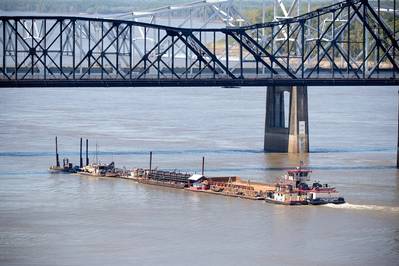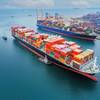Dredging Up Federal Funding for Inland Ports and Waterways
All signals from Washington, D.C., indicate that Fiscal Year (FY) 2022 could be a record-breaking year for inland port and waterway investment. The successful opening of the Harbor Maintenance Trust Fund, a recording-breaking United States Army Corps of Engineers (USACE) budget request, positive improvements to the Port Infrastructure Development Program, and a possible bipartisan infrastructure deal, could result in billions of dollars in additional federal investment in inland ports and waterways.
Opening the Harbor Maintenance Trust Fund
On May 28, 2021, the President submitted his FY 2022 budget proposal, which set a new high water mark for proposed USACE Civil Works Program funding. According to a USACE press release, the proposed budget “would provide $6.8 billion in gross discretionary funding, including $5 billion from the General Fund of the Treasury, $52 million from the Inland Waterways Trust Fund, $1.6 billion—the highest amount ever requested—from the Harbor Maintenance Trust Fund, and an estimated $47 million from Special Recreation User Fees.” Acting Assistant Secretary of the Army for Civil Works Jaime Pinkham voiced full support for the budget proposal, stating, “The Army Civil Works FY 2022 Budget—the highest annual Budget ever requested for the Civil Works program—focuses on investments that yield high economic and environmental returns, while increasing resiliency to climate change, promoting environmental justice and opportunity in disadvantaged communities, and supporting a strong economy by accelerating and improving the delivery of water resources products and services.” The focus on environmental returns, climate change resiliency, and environmental justice, of course, aligns with the overall priorities of the Biden-Harris administration.
News of the increased funding request out of the Harbor Maintenance Trust Fund (HMTF) was undoubtedly welcome news to Chair of the House Committee on Transportation and Infrastructure Peter DeFazio (D-Ore.), who championed unlocking the HMTF (which has an estimated balance of $9.2 billion at the beginning of FY 2021) for many years. Chairman DeFazio finally found success with the Water Resources Development Act of 2020 (WRDA 2020), which was passed as part of the Consolidated Appropriations Act, 2021, in late December 2020. WRDA 2020 altered the discretionary spending caps of the HMTF, so offsets elsewhere in the budget are generally no longer required when Congress spends HMTF funds. WRDA 2020 also directs the allocation of operation and maintenance expenditures from the HMTF to address critical dredging needs of emerging harbors, donor and energy transfer ports, commercial strategic ports, and Great Lakes Harbors. Accordingly, the $1.6 billion in HMTF spending proposed for FY 2022 should be the mere beginning, with stakeholders anticipating that spending will continue to increase in future years.
Port Infrastructure Development Program benefits small ports
The President’s FY 2022 budget proposal also seeks the appropriation of $230 million in grant funding for the Maritime Administration’s (MARAD) Port Infrastructure Development Program (PIDP), which matches the funding provided in the current fiscal year. On March 29, 2021, MARAD published its FY 2021 PIDP Notice of Funding Opportunity, which implemented amendments to the PIDP enacted in January under the National Defense Authorization Act for Fiscal Year 2021 (NDAA). The NDAA amendments were specifically intended to benefit small inland ports. Prior to the NDAA amendments, “small projects” were generally defined to mean projects requesting $10 million. This amount often exceeded the project size at smaller inland ports. Under the NDAA amendments, however, eighteen percent of the available funding ($41.4 million for FY 2021) is available for “small projects at small ports”. To be deemed a “small port” the applicant must have an average annual tonnage of cargo during the three calendar years immediately preceding the time of application of less than 8,000,000 short tons. In addition, to be deemed a “small project” the applicant can request no more than $4.14 million in PIDP grant funding. The minimum grant also has been lowered to $1 million, providing a tremendous opportunity for inland ports to accomplish smaller projects. Applications are due by July 30, 2021, with awards to be made sometime in the fall.

Photo: Joe Premozic / U.S. Army Corps of Engineers
Long-awaited infrastructure package
On June 24, 2021, President Biden announced that he had reached agreement on a $1.2 trillion bipartisan infrastructure deal entitled the Bipartisan Infrastructure Framework. According to a White House Fact Sheet, the infrastructure package would include $16 billion in funding for ports and waterways. While the initial announcement was encouraging, passage of the funding package was immediately thrown into doubt by President Biden’s statement that he would not sign the Bipartisan Infrastructure Framework if Congress did not also pass a separate reconciliation bill enacting the rest of his agenda. President Biden walked the statement back, but as of the time of writing it was unclear whether the President would be able to build support with at least ten Senate Republicans, whose votes will be necessary to overcome a filibuster. Further confusion was added by Speaker Pelosi, who stated that the House would not take up the bipartisan infrastructure bill until the Senate passed the reconciliation bill. Indeed, the infrastructure framework faces challenges on both sides of the aisle with some Democrats questioning whether the framework does enough to address climate change and numerous Republicans questioning the funding sources.
Moreover, at present, the infrastructure framework lacks any real detail as to how the funding (including the $16 billion in funding for ports and waterways) would be allocated and prioritized. There is clearly much more work to be done in the coming months, but the fundamental agreement on an initial framework is an important foundational step. Undoubtedly, debates over the Bipartisan Infrastructure Framework and FY 2022 USACE and PIDP appropriations will become interwoven. However, with continued Congressional support, inland port and maritime stakeholders could end up major winners during the next federal funding cycle.












